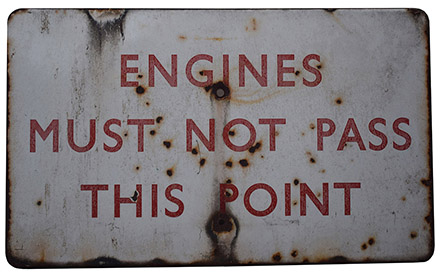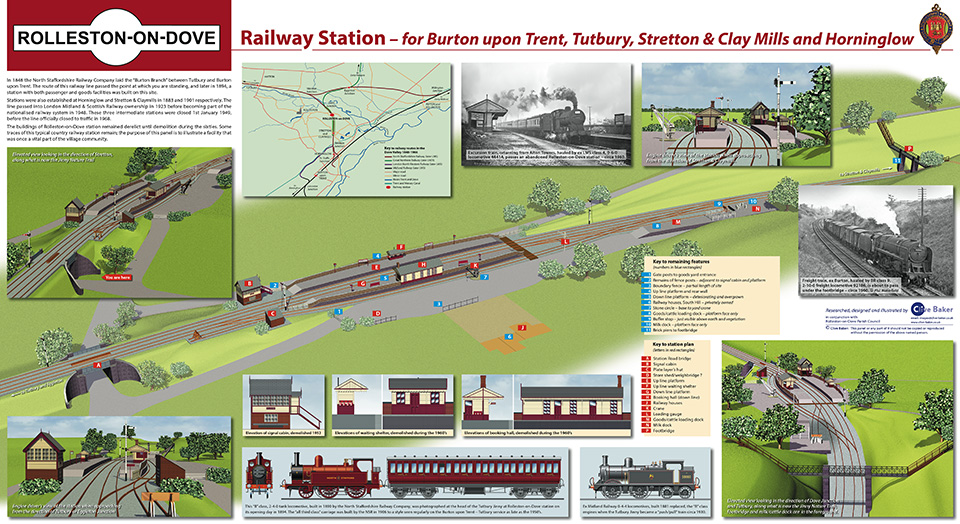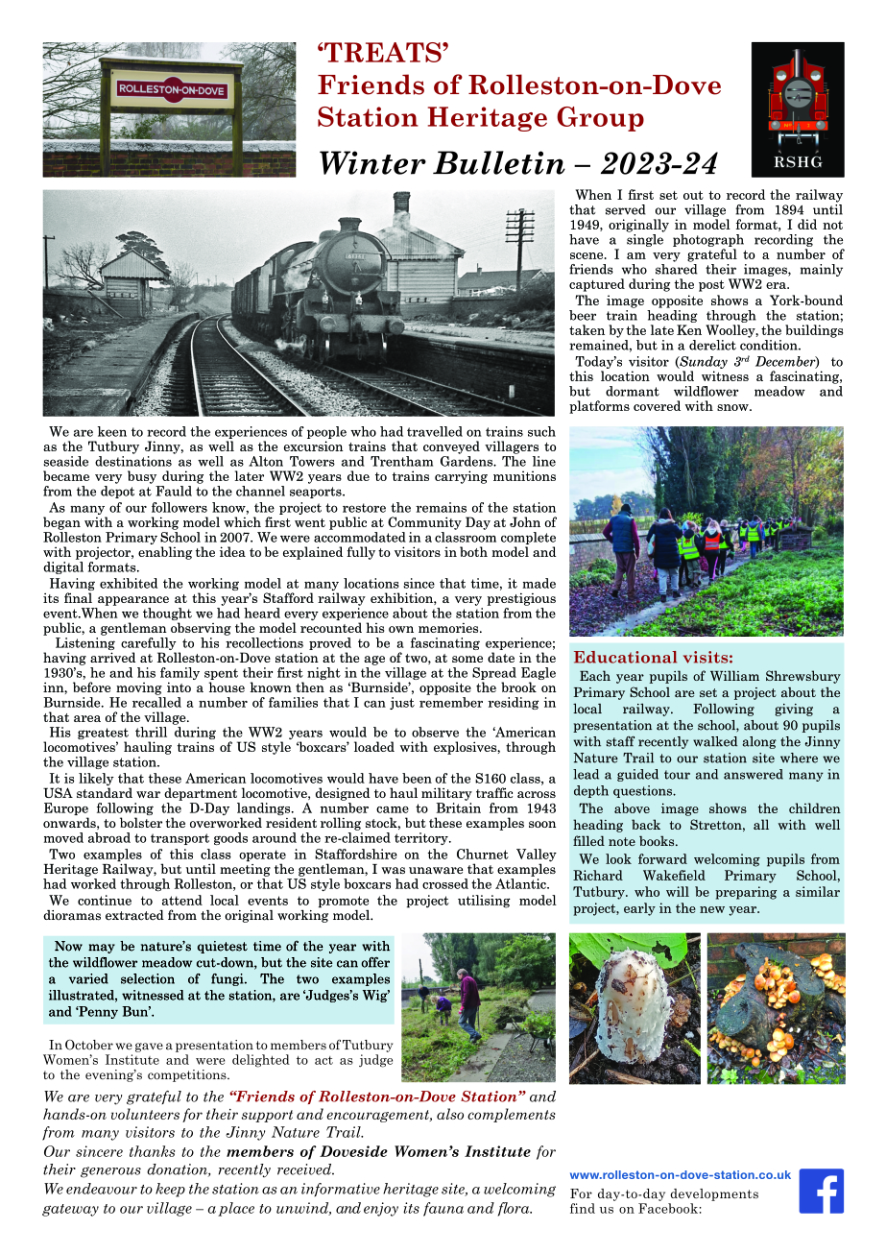STOLEN from the HERITAGE STATION SITE

This sign kindly donated by a Rolleston family, who wanted to help enhance the restored station site, was stolen from the carriage dock wall, where it had been mounted for others to appreciate, between the afternoon of Tuesday 30th January and that of Thursday 1st February 2018. This piece of local history is still missing. If you see this sign at an auction or railwayana outlet, please contact us: clive@rolleston-on-dove-heritage-station.co.uk
Creating a heritage site:
Operating the model at various exhibitions, particularly two in the village of Rolleston-on-Dove itself, made Clive aware that many present-day villagers are unaware of the their local railway heritage. As a result, following the near completion of the actual model, a 3-dimensional virtual version was generated with the idea of producing interpretation panels, utilising renders taken from the virtual model, to be positioned at strategic points around the station site.
A proposal, highlighting how such media could enhance the experience of walking along the Jinny Nature Trail, was submitted to the Parish Council in 2009. This idea had been partly inspired by the rejuvenation of the closed station at Breadsall, to the north of Derby, where the old track bed is part of the "Great Northern Greenway". By restoring the platforms and foot-printing associated buildings together with signage, history had been brought to life.
In 2009, on Spring Monday, Rolleston-on-Dove had, for the first time, played host to vintage and classic road vehicles; this event, known as the "Transport Festival", has been repeated each year, growing in size and popularity. From this event a number of interested persons formed a group known as "The Rolleston Engineering and Transport Society" or "TREATS". In 2012, by which time Clive had almost given-up on his vision for the station, he was invited to present a lecture to TREATS, explaining the history of the village railway and his ideas for the future of its remains.
Later that year the Parish Council asked Clive to design and prepare artwork for an information panel, as originally envisaged, including the virtual reconstruction of the railway station together with map, track plan, illustrations of buildings, rolling stock and historic photographs, see panel at top of page. This panel now stands on Station Road, by the entrance to the Jinny Nature Trail and the one-time railway goods yard.
In 2013 the "Station Group" under the TREATS umbrella was formed and a detailed proposal document submitted to the Parish Council. The initial stage to renovate the up-line or southbound platform, seen in photographs, construct a replica station nameboard to be positioned in its original location and create a wildflower meadow in the area between the two platforms won approval. Working parties began imediately assessing the work needed by clearing brambles and other vegetation from the up-line platform and various specialists were consulted and funding sought.
Early in April 2014 the project was awarded £7,600.00 from the Heritage Lottery Fund, followed in July by a donation of £500.00 from the Rolleston Transport Festival Committee. A contractor cleared the platform area, the southbound platform re-edged with slabs and the northbound platform partly re-edged. The two platform gardens/rockeries are re-instated and the shaded areas stocked with ferns and woodland flowers reared and planted by local residents including Mr and Mrs Joe Martin. Interpretation panels describing the station buildings and equipment as well as the fauna and flora to be found along the Jinny Nature Trail have been installed. Wild flower seeds have been sown in the area between the platforms with the assistance of Rolleston Guides and Brownies and pupils from John of Rolleston Primary School.
Saturday 1st November marked the 120th anniversary of the opening of the station, so the opportunity for a celebration could not be missed. The day dawned and the sun came out to greet 75 invited guests, and a similar number of village residents, to witness the unveiling of a replica station name board by the Mayor and Mayoress of East Staffordshire Borough Council, Councillor Ron Clarke and Mrs Clarke. Also attending – Mrs K. Griffiths, the current Member of Parlaiment, Rolleston Parish Council chairman, Mr James Toon and Borough Councillor Mrs Beryl Toon. Special guests, Mr and Mrs David Penlington travelled from Cumbria. Mr Penlington, having spent his boyhood at one of the adjacent station houses, has provided a vital insight into the activities of the station during its latter years, before closure. The accompanying photograph shows the guests assembled in front of the new station name board and includes four pupils of John of Rolleston Primary School who presented posies.
To compliment the name board, built by TREATS member Mr Alex Thorp, a little further along the south bound platform, the visitor can relax on the newly-installed traditional platform bench, bearing the name "Rolleston" carved on the seat back by village resident Mr Joe Martin.
Wildflower meadow and woodland spring flora:
Thanks to the efforts of the Station Heritage Group, following much winter weeding and thinning of not so popular varieties, visitors each season are able to enjoy a bevy of wildflowers. The year commences with snowdrops, followed by crocuses, daffodils, bluebells, forget-me-nots before the area between the two platforms becomes a sea of wildflowers which frequently continue to bloom well into the autumn. Much of the flora has been donated by residents, in particular bluebells in memory of the late Guide and Brownie leader Mrs Delia Wyers, purple crocuses representing the fight against polio, donated by Burton Rotary Club and the daffodil bulbs planted on the bank by Station Road which have created such a magnificent shop window for the station.
In remembrance:
Plaques commemorating the lives of the many service people who would have used the station during 2 World Wars are installed above the two restored platform gardens. Each garden has, as a centrepiece, a Rosemary plant, the symbol of Remembrance.
Walk Guide:
To enjoy a guided walk along the Jinny Nature Trail between Rolleston-on-Dove and Stretton & Claymills stations, returning via Craythorne Lane and field paths, please download the Station Walk Guide.
Recent developments:
Freequently passed un-noticed, the concrete gradiant sign has now been painted and new letters and numbers attached. Possibly a modern unit installed when the line was re-signalled in 1955; cast in concrete, with metal characters set into the concrete before setting, it can be found almost opposite the buffer stop on the east side of the trail.
With the wall adjacent to the buffer stop rebuilt, the team completed the refurbishment of the buffer stop by attaching two lengths of bullhead rail to form cross members at the February 2017 working party session. This piece of railway equipment is unusual and may be a rare relic because, as the photograph indicates, it is positioned touching the end wall with no supporting angles to the rear. The platform behind the buffers is described on an early map of the station track layout as a 'carriage dock' and not a milk dock, as first assumed. The unusual design of the buffer stop enabled end-loading of horse-drawn carriages and carts, it being common practise during the early years of rail travel for the gentry to take their carriage and possibly horses with them when travelling to other parts of the country. A new interpretation panel indicating the process of transferring a road vehicle on to a railway wagon has recently been installed; also indicating how the track layout was modified soon after the station opened, period photographs are also included.
The most important part of the station, namely the booking hall where tickets were purchased and parcels deposited and collected, is now represented by a footprint; originally a timber structure mounted on a brick foundation, the reconstruction of that base is now complete enabling the visitor, with the aid of the signage, to recognise the location of each of the four rooms – ticket office, general waiting room, ladies waiting room with WC and similar facilities for gentlemen. To view click on the Prototype/History button.
It is important that the station area of the Jinny Nature Trail remains sympathetic to its status, but with interpretation panels placed at strategic locations describing both railway heritage as well as fauna and flora, the remains of structures built by the North Staffordshire Railway Company, part of a transport system that changed and enhanced the lives of local people in 1894, should once more enliven the experience for local people and their visitors when enjoying the Jinny Nature Trail.
Find us on Facebook:


